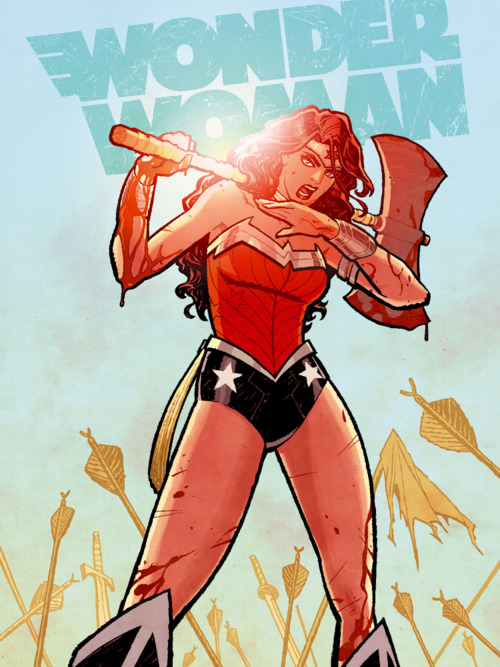In 2011, when DC Comics announced they were going to relaunch their entire line of superhero comics, I expressed cautious optimism that their books would be aimed at expanding their audience to the millions of people who love Superman and Batman in movies, cartoons, and video games, but who do not read comics. Freed from 70+ years of continuity, writers and artists could stretch both the characters and the genre in new directions, really experiment with what a superhero story could be. I was disappointed, to say the least.
The “New 52” relaunch has undeniably been a financial success. According to Marc-Oliver Frisch at The Beat: “September 2013 is, by quite a margin, the most successful month ever for DC Comics since Diamond started providing data on actual comic-book sales to retailers in March 2003.” However, DC Comics didn’t reach many new readers at all. Instead, they achieved their success by simply selling more comics to the already existing readership. Additionally, odd numbering tricks (zero issues, .1 issues), an emphasis on crossover driven storytelling, substandard writing and art, and problematic representations of women seemed almost designed to drive away new readers.
There are exceptions, books that managed to be great almost in spite of the DC relaunch. And the series that best exemplifies what I had hoped the New 52 would be, new reader friendly, forward thinking, and exceptionally executed, is Brian Azzarello and Cliff Chiang’s ongoing run on Wonder Woman.
For one thing, Wonder Woman is entirely self-contained. Except for a vague understanding that Wonder Woman is a superhero from an island of mythical Amazons, a reader needs to know nothing before diving in with issue 1. The storyline never crosses over with any other series, or really acknowledges that other superheroes even exist. In fact, other than nods to stunt months like “Zero Month” and “Villains Month,” Azzarello writes Wonder Woman as if the rest of the DC Universe books don’t exist at all.
Which is great, because it means no one else’s crappy writing gets in the way of the fantastic story he’s telling. The basic plot is that Zeus has vanished, leading to a power struggle on Olympus centered around the birth of Zeus’s latest and possibly last child, prophesied to destroy the world. Wonder Woman swears to protect the mother and child from all comers, jealous Hera, ambitious Apollo, an assortment of angry gods both old and new, and other children of Zeus, including his monstrous First Born. The book is a combination of superheroes and myths, and also horror comics and crime fiction. Anyone who’s read Azzarello’s 100 Bullets will recognize the central theme: when one family rules the world, domestic squabbles have traumatic, apocalyptic results.
The real attraction, however, is Cliff Chiang’s art. Chiang has an elegant, clean style which allows his characters’ actions and emotions to pop-off the page. His Wonder Woman, based on Jim Lee’s redesign, is muscular and active, a warrior quick to bloody her blade. The gods are not anthropomorphic figures in togas, but actual incarnations of their domain. Demeter is made of plants, Hephaestus resembles an active volcano, Aphrodite is too beautiful to ever be captured on the page. The fight scenes sing—brutal, wild affairs in which Wonder Woman faces down gods, but the action is still easy to follow and understand. It’s only a shame that Chiang physically can’t draw every issue. Back up artists Tony Atkins and Goran Sudzuka are competent draftsmen who can ape Chiang’s designs, but they can’t bring the same humor and life to the page.
The book’s not perfect. One problem is that Wonder Woman is the least interesting character in her cast. Wonder Woman is sort of generically heroic. She has all the virtues of a hero (courage, intelligence, compassion, and strength) but not much that’s unique to her. And the story, so far, hasn’t really been about her. It’s really been about Zola, the mother of Zeus’s last child, and her struggle to protect her son.
However, the latest issue, #24, makes a good jumping on point, because it sets up the new status quo that refocuses the story on Wonder Woman. In defeating the First Born, Wonder Woman’s sometimes mentor Ares dies and Wonder Woman becomes the new God of War, a change neither she nor the other Olympians particularly welcome. The new story arc gives Azzarello and Chiang a chance to play with the central conflict in Wonder Woman’s character: she’s a born and bred warrior on a mission of peace, a compassionate woman who forgives even Hera of her crimes, and yet someone who solves most of her problems with swords, axes, and bloody battle. I’m curious to see how Azzarello and Chiang will resolve that conflict, now that Wonder Woman has literally become War, the thing she most detests.
Wonder Woman is everything I want a superhero comic book series in the 21st Century to be: new reader friendly, female friendly, innovative, smart, funny, exciting, self-contained, and ambitious. You can’t read an issue without seeing Azzarello and Chiang trying to do something new—taking a 70-year-old character and ancient myths and trying to do something with them that hasn’t been done before. You can pick up the first 18 issues in three trade paperback editions on Comixology or your local comic book store, or just hop on with issue #24. I promise you won’t be disappointed.
Steven Padnick is a freelance writer and editor. By day. You can find more of his writing and funny pictures at padnick.tumblr.com.










